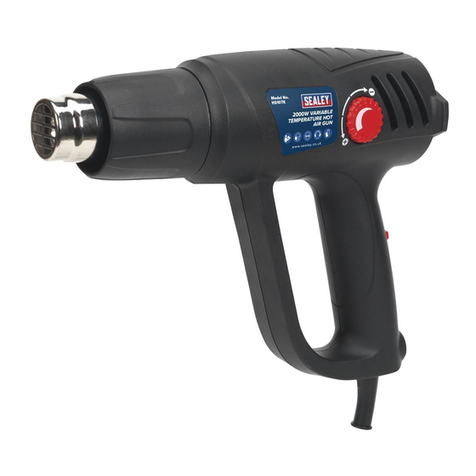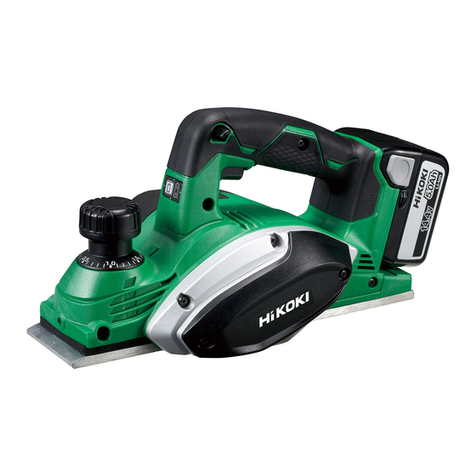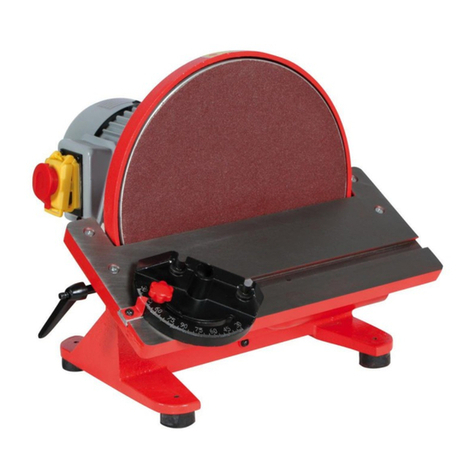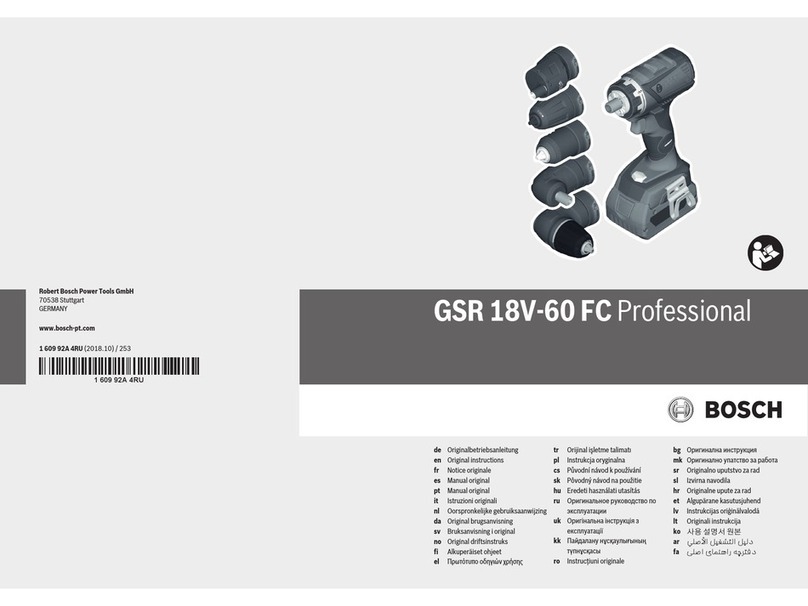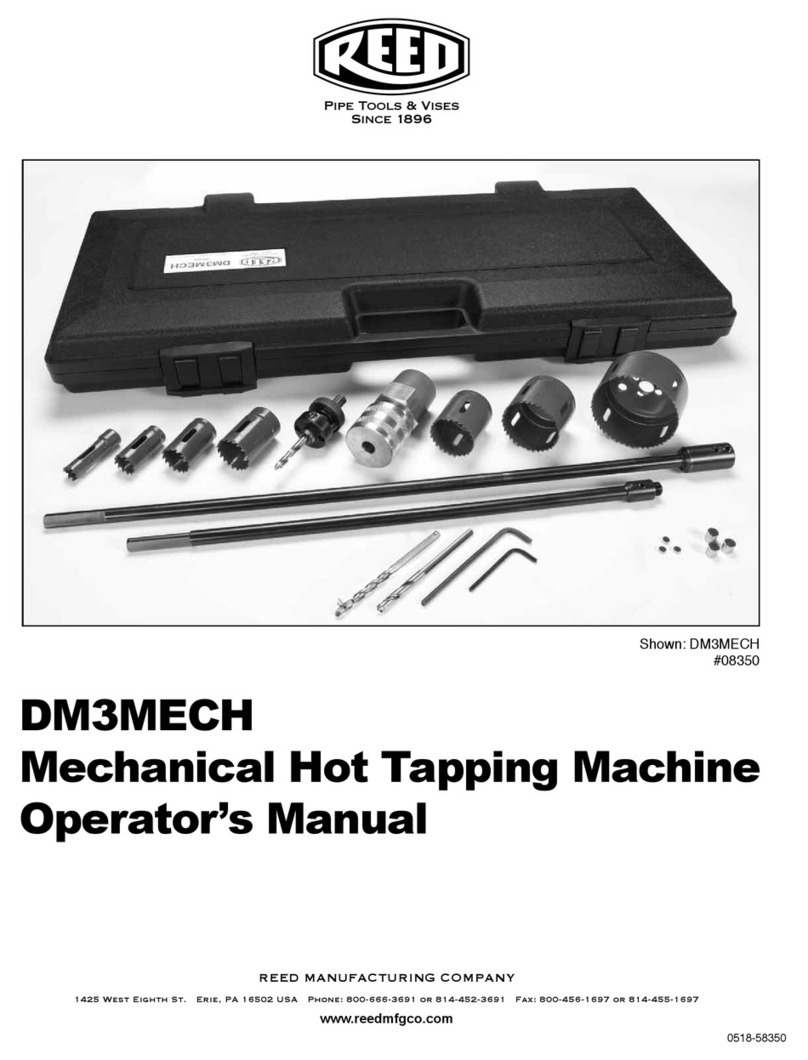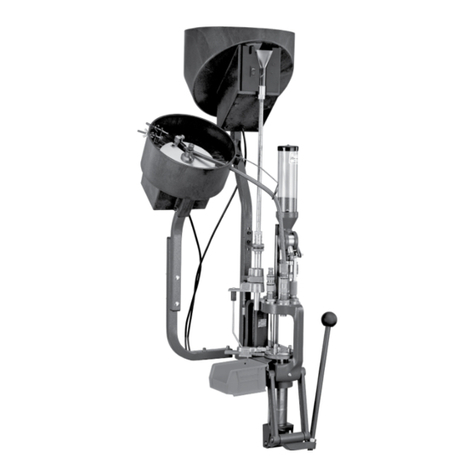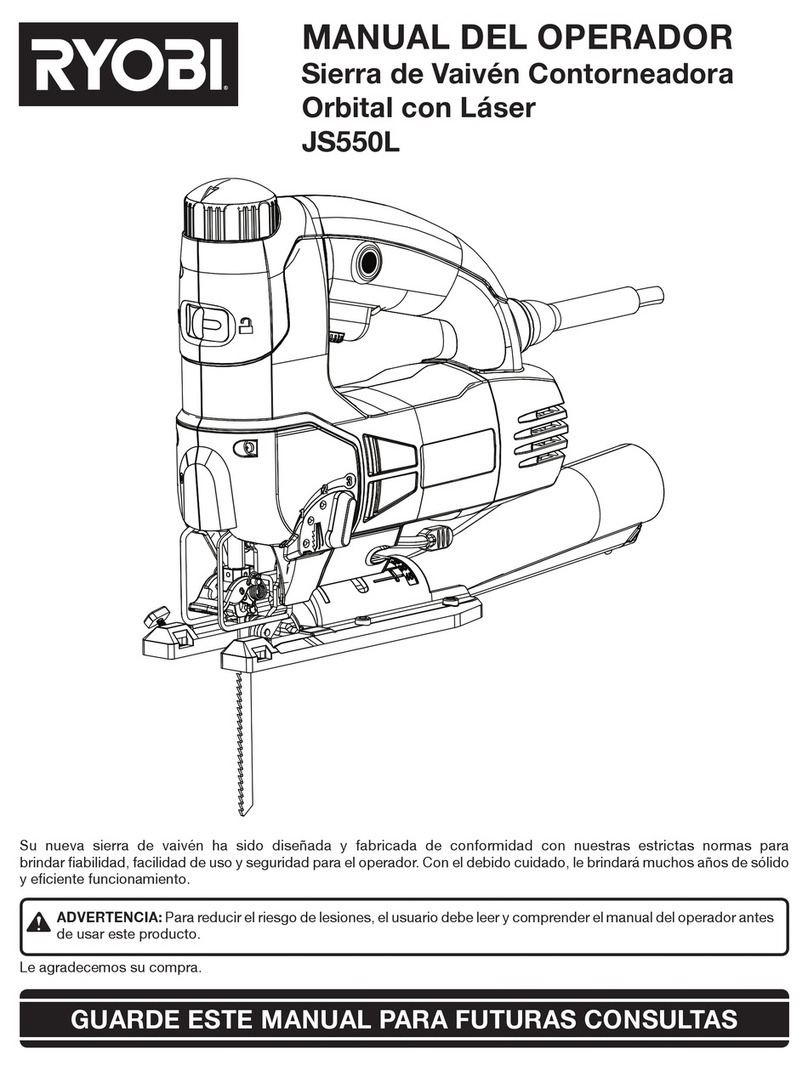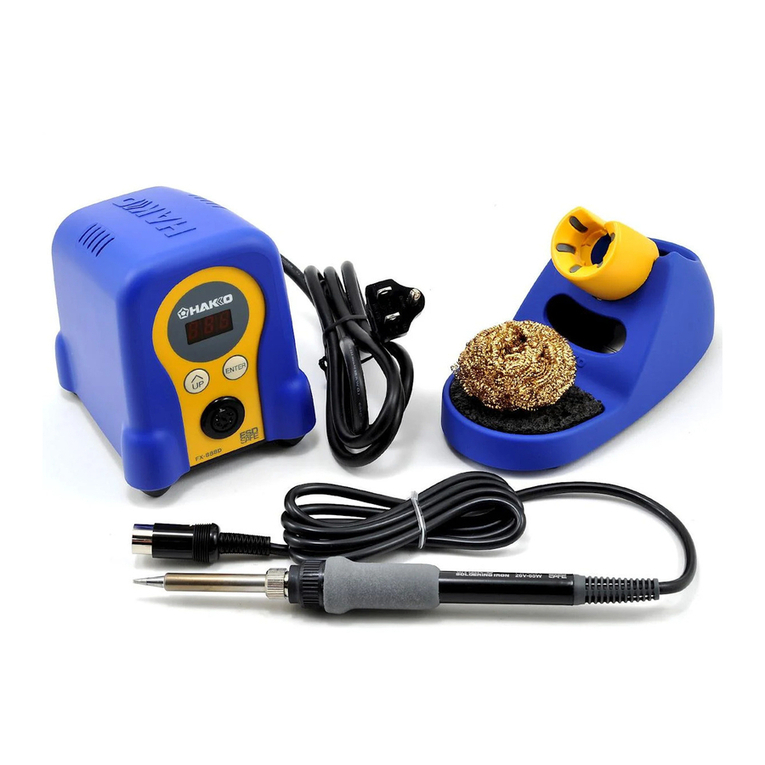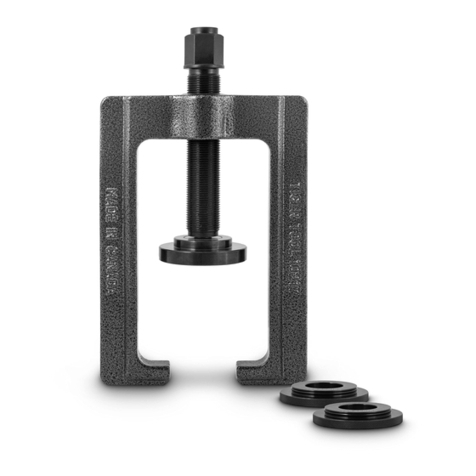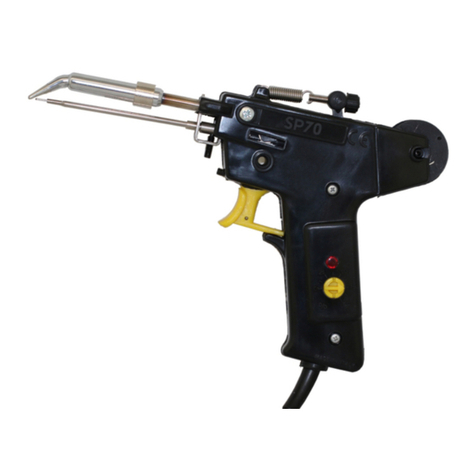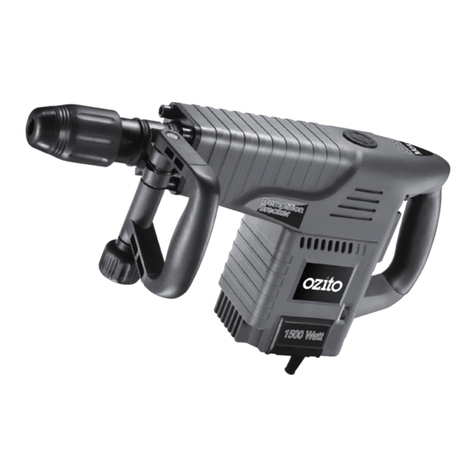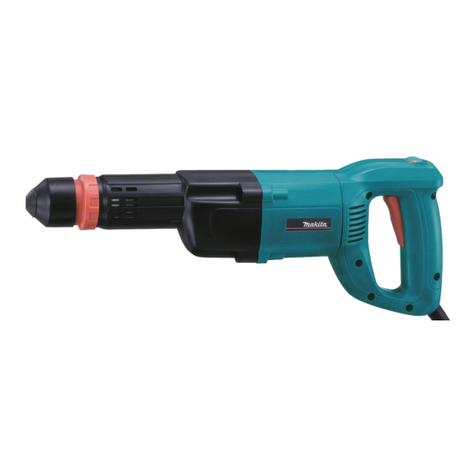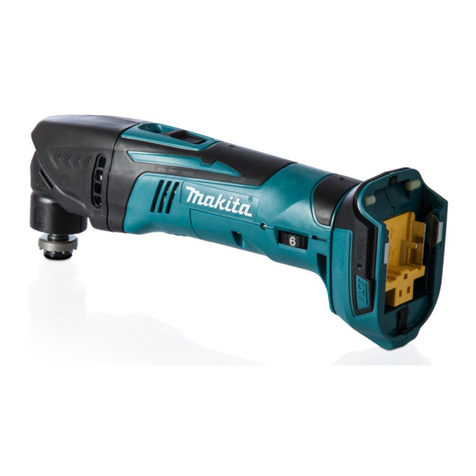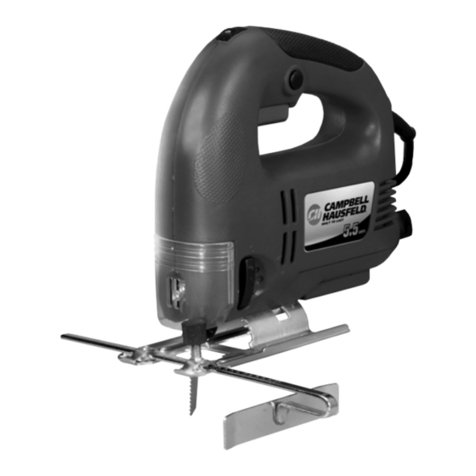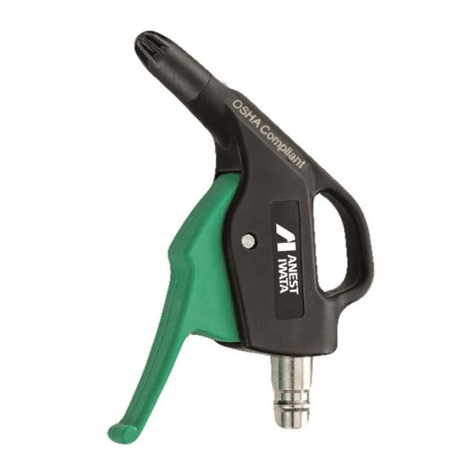Solid-State Laser Spectra-Physics Opal User manual

Opal
Femtosecond Synchronously Pumped
Optical Parametric Oscillator (SPPO)
User’s Manual
The Solid-State Laser Company
1335 Terra Bella Road
Mountain View, CA 94043
Part Number 0000-234A, Rev. E
September 2001


iii
Preface
This manual contains information you need to safely install, align, operate,
maintain, and service your Opal®femtosecond synchronously pumped
optical parametric oscillator (SPPO).
The introductory chapter contains a brief description of the Opal and where
it fits in with the Tsunami®family of products. The Opal is designed for
use with the Tsunami mode-locked, Ti:sapphire laser, pumped by a Millen-
nia®Xssolid state laser or argon ion laser. These are Class IV lasers and
they, as well as the Opal, emit laser radiation that can permanently damage
eyes and skin. The “Laser Safety” section contains information about these
hazards and offers suggestions on how to safeguard against them. To mini-
mize the risk of injury or expensive repairs, read this chapter and carefully
follow these instructions.
“Opal Description” contains a discussion of synchronously pumped optical
parametric oscillators, and it provides a detailed description of the Opal. It
concludes with system specifications and outline drawings.
The middle chapters describe the Opal controls, indicators and connec-
tions, and guide you through its setup and installation, alignment, and oper-
ation. The last part of the manual covers maintenance and service. Included
is a replacement parts list and a short troubleshooting guide. “Customer
Service” contains a general warranty statement and explains how to request
service should you ever need it. It includes a list of world-wide Spectra-
Physics service centers you can call if you need help.
The “Maintenance” section contains information you need to keep your
Opal clean and operational on a day-to-day basis, whereas “Service and
Repair” is intended to help you guide your Spectra-Physics field service
engineer to the source of any problems. Do not attempt repairs yourself
while the unit is still under warranty. Instead, report all problems to Spectra-
Physics for warranty repair.
This product has been tested and found to conform to “Directive 89/336/
EEC for Electromagnetic Compatibility.” Class A compliance was demon-
strated for “EN 50081-2:1993 Emissions” and “EN 50082-1:1992 Immunity”
as listed in the official Journal of the European Communities. It also meets
the intent of “Directive 73/23/EEC for Low Voltage.” Class A compliance
was demonstrated for “EN 61010-1:1993 Safety Requirements for Electrical
Equipment for Measurement, Control and Laboratory use” and “EN 60825-
1:1992 Radiation Safety for Laser Products.” Refer to the “EC Declaration
of Conformity” in Chapter 2, “Laser Safety.”

Opal fs Synchronously Pumped Optical Parametric Oscillator
iv
This equipment has been designed and tested to comply with the limits for
a Class A digital device pursuant to Part 15 of the FCC Rules.
Finally, if you encounter any difficulty with the content or style of this
manual, please let us know. The last page is a form to aid in bringing such
problems to our attention.
Thank you for your purchase of Spectra-Physics instruments.

v
Environmental Specifications
CE Electrical Equipment Requirements
For information regarding the equipment needed to provide the electrical
service listed under “Service Requirements” at the end of Chapter 3, please
refer to specification EN-309, “Plug, Outlet and Socket Couplers for Indus-
trial Uses,” listed in the official Journal of the European Communities.
Environmental Specifications
The environmental conditions under which the laser system will function
are listed below:
Indoor use
Altitude: up to 2000 m
Temperatures: 10° C to 40° C
Maximum relative humidity: 80% non-condensing for temperatures up to
31° C.
Mains supply voltage: do not exceed ±10% of the nominal voltage
Insulation category: II
Pollution degree: 2
FCC Regulations
This equipment has been tested and found to comply with the limits for a
Class A digital device pursuant to Part 15 of the FCC Rules. These limits
are designed to provide reasonable protection against harmful interference
when the equipment is operated in a commercial environment. This equip-
ment generates, uses and can radiate radio frequency energy and, if not
installed and used in accordance with the instruction manual, may cause
harmful interference to radio communications. Operation of this equipment
in a residential area is likely to cause harmful interference in which case
the user will be required to correct the interference at his own expense.
Modifications to the laser system not expressly approved by Spectra-
Physics could void your right to operate the equipment.


vii
Table of Contents
Preface . . . . . . . . . . . . . . . . . . . . . . . . . . . . . . . . . . . . . . . . . . . . . . . . . . . . . . . . . . . . . . iii
Environmental Specifications. . . . . . . . . . . . . . . . . . . . . . . . . . . . . . . . . . . . . . . . . . . . v
Warning Conventions . . . . . . . . . . . . . . . . . . . . . . . . . . . . . . . . . . . . . . . . . . . . . . . . . . xiii
Standard Units . . . . . . . . . . . . . . . . . . . . . . . . . . . . . . . . . . . . . . . . . . . . . . . . . . . . . . . xv
Unpacking and Inspection . . . . . . . . . . . . . . . . . . . . . . . . . . . . . . . . . . . . . . . . . . . . . . xvii
Chapter 1: Introduction . . . . . . . . . . . . . . . . . . . . . . . . . . . . . . . . . . . . . . . . . . . . . . . . 1-1
The Opal®SPPO . . . . . . . . . . . . . . . . . . . . . . . . . . . . . . . . . . . . . . . . . . . . . . . . . . . . . . . . . . . . . . . . . 1-1
Patents . . . . . . . . . . . . . . . . . . . . . . . . . . . . . . . . . . . . . . . . . . . . . . . . . . . . . . . . . . . . . . . . . . . . . . . . . 1-2
Configurations . . . . . . . . . . . . . . . . . . . . . . . . . . . . . . . . . . . . . . . . . . . . . . . . . . . . . . . . . . . . . . . . . . . 1-3
Chapter 2: Laser Safety. . . . . . . . . . . . . . . . . . . . . . . . . . . . . . . . . . . . . . . . . . . . . . . . . 2-1
Precautions for the Safe Operation of Class IV-High Power Lasers and Accessories . . . . . . . . . . . . 2-1
Safety Devices . . . . . . . . . . . . . . . . . . . . . . . . . . . . . . . . . . . . . . . . . . . . . . . . . . . . . . . . . . . . . . . . . . . 2-3
Shutter Interlock . . . . . . . . . . . . . . . . . . . . . . . . . . . . . . . . . . . . . . . . . . . . . . . . . . . . . . . . . . . . . . . 2-3
Maintenance Required to Keep this Laser Product in Compliance with Center for Devices
and Radiological Health (CDRH) Regulations . . . . . . . . . . . . . . . . . . . . . . . . . . . . . . . . . . . . . . . . 2-4
CE/CDRH Radiation Control Drawings . . . . . . . . . . . . . . . . . . . . . . . . . . . . . . . . . . . . . . . . . . . . . . . . . 2-5
Label Translations . . . . . . . . . . . . . . . . . . . . . . . . . . . . . . . . . . . . . . . . . . . . . . . . . . . . . . . . . . . . . 2-7
CE Declaration of Conformity (Emissions) . . . . . . . . . . . . . . . . . . . . . . . . . . . . . . . . . . . . . . . . . . . . . . 2-8
CE Declaration of Conformity (Low Voltage) . . . . . . . . . . . . . . . . . . . . . . . . . . . . . . . . . . . . . . . . . . . . 2-9
Sources for Additional Information . . . . . . . . . . . . . . . . . . . . . . . . . . . . . . . . . . . . . . . . . . . . . . . . . . . . 2-10
Laser Safety Standards . . . . . . . . . . . . . . . . . . . . . . . . . . . . . . . . . . . . . . . . . . . . . . . . . . . . . . . . . 2-10
Equipment and Training . . . . . . . . . . . . . . . . . . . . . . . . . . . . . . . . . . . . . . . . . . . . . . . . . . . . . . . . 2-11
Chapter 3: Opal Description . . . . . . . . . . . . . . . . . . . . . . . . . . . . . . . . . . . . . . . . . . . . . 3-1
OPOs . . . . . . . . . . . . . . . . . . . . . . . . . . . . . . . . . . . . . . . . . . . . . . . . . . . . . . . . . . . . . . . . . . . . . . . . . . 3-1
The Opal . . . . . . . . . . . . . . . . . . . . . . . . . . . . . . . . . . . . . . . . . . . . . . . . . . . . . . . . . . . . . . . . . . . . . . . 3-3
Wavelength Tuning Characteristics . . . . . . . . . . . . . . . . . . . . . . . . . . . . . . . . . . . . . . . . . . . . . . . .3-4
Configuration . . . . . . . . . . . . . . . . . . . . . . . . . . . . . . . . . . . . . . . . . . . . . . . . . . . . . . . . . . . . . . . . . 3-5
The Opal Electronics Module . . . . . . . . . . . . . . . . . . . . . . . . . . . . . . . . . . . . . . . . . . . . . . . . . . . . 3-6
Purging the Cavity . . . . . . . . . . . . . . . . . . . . . . . . . . . . . . . . . . . . . . . . . . . . . . . . . . . . . . . . . . . . . 3-6
Opal Specifications . . . . . . . . . . . . . . . . . . . . . . . . . . . . . . . . . . . . . . . . . . . . . . . . . . . . . . . . . . . . . . . 3-8
Outline Drawings . . . . . . . . . . . . . . . . . . . . . . . . . . . . . . . . . . . . . . . . . . . . . . . . . . . . . . . . . . . . . . . . . 3-9
References . . . . . . . . . . . . . . . . . . . . . . . . . . . . . . . . . . . . . . . . . . . . . . . . . . . . . . . . . . . . . . . . . . 3-9

Opal fs Synchronously Pumped Optical Parametric Oscillator
viii
Chapter 4: Controls, Indicators and Connections . . . . . . . . . . . . . . . . . . . . . . . . . . . 4-1
Opal Head . . . . . . . . . . . . . . . . . . . . . . . . . . . . . . . . . . . . . . . . . . . . . . . . . . . . . . . . . . . . . . . . . . . . . .4-1
Input Bezel Connections . . . . . . . . . . . . . . . . . . . . . . . . . . . . . . . . . . . . . . . . . . . . . . . . . . . . . . . .4-2
Opto-Mechanical Controls . . . . . . . . . . . . . . . . . . . . . . . . . . . . . . . . . . . . . . . . . . . . . . . . . . . . . . .4-2
Opal Electronics Module . . . . . . . . . . . . . . . . . . . . . . . . . . . . . . . . . . . . . . . . . . . . . . . . . . . . . . . . . . . .4-5
Front Panel . . . . . . . . . . . . . . . . . . . . . . . . . . . . . . . . . . . . . . . . . . . . . . . . . . . . . . . . . . . . . . . . . . .4-5
Rear Panel . . . . . . . . . . . . . . . . . . . . . . . . . . . . . . . . . . . . . . . . . . . . . . . . . . . . . . . . . . . . . . . . . . .4-6
Chapter 5: Installation and Alignment. . . . . . . . . . . . . . . . . . . . . . . . . . . . . . . . . . . . . 5-1
Opal Installation . . . . . . . . . . . . . . . . . . . . . . . . . . . . . . . . . . . . . . . . . . . . . . . . . . . . . . . . . . . . . . . . . .5-1
Setting up the System . . . . . . . . . . . . . . . . . . . . . . . . . . . . . . . . . . . . . . . . . . . . . . . . . . . . . . . . . .5-2
Removing/Installing the LBO Crystal . . . . . . . . . . . . . . . . . . . . . . . . . . . . . . . . . . . . . . . . . . . . . . .5-3
Aligning the Opal Head . . . . . . . . . . . . . . . . . . . . . . . . . . . . . . . . . . . . . . . . . . . . . . . . . . . . . . . . .5-5
Attaching the Opal Purge Line . . . . . . . . . . . . . . . . . . . . . . . . . . . . . . . . . . . . . . . . . . . . . . . . . . . .5-7
Removing the Opal Purge Line . . . . . . . . . . . . . . . . . . . . . . . . . . . . . . . . . . . . . . . . . . . . . . . . . . .5-9
Opal Alignment—1.3 µm Optic Set . . . . . . . . . . . . . . . . . . . . . . . . . . . . . . . . . . . . . . . . . . . . . . . . . . . .5-9
Initial Set-up . . . . . . . . . . . . . . . . . . . . . . . . . . . . . . . . . . . . . . . . . . . . . . . . . . . . . . . . . . . . . . . . . .5-9
Aligning the Pump Beam . . . . . . . . . . . . . . . . . . . . . . . . . . . . . . . . . . . . . . . . . . . . . . . . . . . . . . . .5-11
Aligning the Opal Cavity . . . . . . . . . . . . . . . . . . . . . . . . . . . . . . . . . . . . . . . . . . . . . . . . . . . . . . . . .5-12
Alignment of Pr1and Pr2Prism Sequence . . . . . . . . . . . . . . . . . . . . . . . . . . . . . . . . . . . . . . . . . .5-14
Completing the Cavity Alignment . . . . . . . . . . . . . . . . . . . . . . . . . . . . . . . . . . . . . . . . . . . . . . . . . .5-15
Aligning the Beam to the Servo Wavelength Monitor Assembly . . . . . . . . . . . . . . . . . . . . . . . . . .5-16
Completing the Alignment . . . . . . . . . . . . . . . . . . . . . . . . . . . . . . . . . . . . . . . . . . . . . . . . . . . . . . .5-17
Opal Alignment—1.5 µm Optic Set . . . . . . . . . . . . . . . . . . . . . . . . . . . . . . . . . . . . . . . . . . . . . . . . . . . .5-19
Initial Set-up . . . . . . . . . . . . . . . . . . . . . . . . . . . . . . . . . . . . . . . . . . . . . . . . . . . . . . . . . . . . . . . . . .5-19
Aligning the Pump Beam . . . . . . . . . . . . . . . . . . . . . . . . . . . . . . . . . . . . . . . . . . . . . . . . . . . . . . . .5-20
Aligning the Opal Cavity . . . . . . . . . . . . . . . . . . . . . . . . . . . . . . . . . . . . . . . . . . . . . . . . . . . . . . . . .5-21
Completing the Cavity Alignment . . . . . . . . . . . . . . . . . . . . . . . . . . . . . . . . . . . . . . . . . . . . . . . . . .5-23
Aligning the Beam to the Servo Wavelength Monitor . . . . . . . . . . . . . . . . . . . . . . . . . . . . . . . . . . .5-24
Completing the Alignment . . . . . . . . . . . . . . . . . . . . . . . . . . . . . . . . . . . . . . . . . . . . . . . . . . . . . . .5-25
Converting from 1.3 to 1.5 µm . . . . . . . . . . . . . . . . . . . . . . . . . . . . . . . . . . . . . . . . . . . . . . . . . . . . . . .5-27
Converting from 1.5 to 1.3 µm . . . . . . . . . . . . . . . . . . . . . . . . . . . . . . . . . . . . . . . . . . . . . . . . . . . . . . .5-28
Chapter 6: Operation . . . . . . . . . . . . . . . . . . . . . . . . . . . . . . . . . . . . . . . . . . . . . . . . . . 6-1
General Operation . . . . . . . . . . . . . . . . . . . . . . . . . . . . . . . . . . . . . . . . . . . . . . . . . . . . . . . . . . . . . . . .6-1
Turning On the System . . . . . . . . . . . . . . . . . . . . . . . . . . . . . . . . . . . . . . . . . . . . . . . . . . . . . . . . .6-2
Resetting the Wavelength . . . . . . . . . . . . . . . . . . . . . . . . . . . . . . . . . . . . . . . . . . . . . . . . . . . . . . . .6-4
Turning Off the System . . . . . . . . . . . . . . . . . . . . . . . . . . . . . . . . . . . . . . . . . . . . . . . . . . . . . . . . .6-4
Purging the Opal . . . . . . . . . . . . . . . . . . . . . . . . . . . . . . . . . . . . . . . . . . . . . . . . . . . . . . . . . . . . . . . . . .6-5
Purge Turn-on . . . . . . . . . . . . . . . . . . . . . . . . . . . . . . . . . . . . . . . . . . . . . . . . . . . . . . . . . . . . . . . .6-6
Purge Turn-off . . . . . . . . . . . . . . . . . . . . . . . . . . . . . . . . . . . . . . . . . . . . . . . . . . . . . . . . . . . . . . . .6-6
The Front Panel Menu Control System . . . . . . . . . . . . . . . . . . . . . . . . . . . . . . . . . . . . . . . . . . . . . . . .6-6
The Menus . . . . . . . . . . . . . . . . . . . . . . . . . . . . . . . . . . . . . . . . . . . . . . . . . . . . . . . . . . . . . . . . . . . . . .6-7
Main Menu (MAIN) . . . . . . . . . . . . . . . . . . . . . . . . . . . . . . . . . . . . . . . . . . . . . . . . . . . . . . . . . . . . .6-9
Scan Menu (SCAN) . . . . . . . . . . . . . . . . . . . . . . . . . . . . . . . . . . . . . . . . . . . . . . . . . . . . . . . . . . . .6-10
Scan Status Menu (SCAN) . . . . . . . . . . . . . . . . . . . . . . . . . . . . . . . . . . . . . . . . . . . . . . . . . . . . . .6-11
Paused Scan Status Menu (SCAN) . . . . . . . . . . . . . . . . . . . . . . . . . . . . . . . . . . . . . . . . . . . . . . . .6-11
Remote Menu (REMOTE) . . . . . . . . . . . . . . . . . . . . . . . . . . . . . . . . . . . . . . . . . . . . . . . . . . . . . . .6-12
Adjust Temp Menu (ADJUST TEMPERATURE) . . . . . . . . . . . . . . . . . . . . . . . . . . . . . . . . . . . . .6-12
Clear Menu (ADJUST TEMPERATURE) . . . . . . . . . . . . . . . . . . . . . . . . . . . . . . . . . . . . . . . . . . . .6-14
Setup Menu (SETUP) . . . . . . . . . . . . . . . . . . . . . . . . . . . . . . . . . . . . . . . . . . . . . . . . . . . . . . . . . .6-15
Scan Length Menu (SETUP) . . . . . . . . . . . . . . . . . . . . . . . . . . . . . . . . . . . . . . . . . . . . . . . . . . . . .6-16

Table of Contents
ix
Scanning Coarse Length Menu (SETUP) . . . . . . . . . . . . . . . . . . . . . . . . . . . . . . . . . . . . . . . . . . . 6-16
Configure Menu (CONFIGURE) . . . . . . . . . . . . . . . . . . . . . . . . . . . . . . . . . . . . . . . . . . . . . . . . . . 6-17
Save/Recall Menu (CONFIGURATION) . . . . . . . . . . . . . . . . . . . . . . . . . . . . . . . . . . . . . . . . . . . . 6-17
Miscellaneous (CONFIGURATION) . . . . . . . . . . . . . . . . . . . . . . . . . . . . . . . . . . . . . . . . . . . . . . . 6-18
Diagnostics Menu (DIAGNOSTICS) . . . . . . . . . . . . . . . . . . . . . . . . . . . . . . . . . . . . . . . . . . . . . . . 6-19
Manual Control Menu (DIAGNOSTICS) . . . . . . . . . . . . . . . . . . . . . . . . . . . . . . . . . . . . . . . . . . . . 6-19
Scanning Coarse Length Menu (DIAGNOSTICS) . . . . . . . . . . . . . . . . . . . . . . . . . . . . . . . . . . . . . 6-21
Wavelength Calibration (DIAGNOSTICS) . . . . . . . . . . . . . . . . . . . . . . . . . . . . . . . . . . . . . . . . . . . 6-21
Chapter 7: Maintenance . . . . . . . . . . . . . . . . . . . . . . . . . . . . . . . . . . . . . . . . . . . . . . . . 7-1
Notes on the Cleaning of Laser Optics . . . . . . . . . . . . . . . . . . . . . . . . . . . . . . . . . . . . . . . . . . . . . . . . 7-1
Equipment Required: . . . . . . . . . . . . . . . . . . . . . . . . . . . . . . . . . . . . . . . . . . . . . . . . . . . . . . . . . . . 7-2
Removing and Cleaning Opal Optics . . . . . . . . . . . . . . . . . . . . . . . . . . . . . . . . . . . . . . . . . . . . . . . . . . 7-2
Standard Cleaning Procedures . . . . . . . . . . . . . . . . . . . . . . . . . . . . . . . . . . . . . . . . . . . . . . . . . . . . . . 7-3
General Procedure for Cleaning all Optics Except the Crystal . . . . . . . . . . . . . . . . . . . . . . . . . . . 7-4
General Procedure for Cleaning the Crystal . . . . . . . . . . . . . . . . . . . . . . . . . . . . . . . . . . . . . . . . . 7-6
Chapter 8: Service and Repair . . . . . . . . . . . . . . . . . . . . . . . . . . . . . . . . . . . . . . . . . . . 8-1
Troubleshooting Guide . . . . . . . . . . . . . . . . . . . . . . . . . . . . . . . . . . . . . . . . . . . . . . . . . . . . . . . . . . . . . 8-1
Replacement Parts . . . . . . . . . . . . . . . . . . . . . . . . . . . . . . . . . . . . . . . . . . . . . . . . . . . . . . . . . . . . . . . . 8-6
Chapter 9: Customer Service . . . . . . . . . . . . . . . . . . . . . . . . . . . . . . . . . . . . . . . . . . . . 9-1
Warranty . . . . . . . . . . . . . . . . . . . . . . . . . . . . . . . . . . . . . . . . . . . . . . . . . . . . . . . . . . . . . . . . . . . . . . . . 9-1
Return of the Instrument for Repair . . . . . . . . . . . . . . . . . . . . . . . . . . . . . . . . . . . . . . . . . . . . . . . . . . . 9-2
Service Centers . . . . . . . . . . . . . . . . . . . . . . . . . . . . . . . . . . . . . . . . . . . . . . . . . . . . . . . . . . . . . . . . . . 9-3
Appendix A: Setting the Line Voltage Switch . . . . . . . . . . . . . . . . . . . . . . . . . . . . . . . A-1
Appendix B: GVD Compensation . . . . . . . . . . . . . . . . . . . . . . . . . . . . . . . . . . . . . . . . . B-1
Introduction . . . . . . . . . . . . . . . . . . . . . . . . . . . . . . . . . . . . . . . . . . . . . . . . . . . . . . . . . . . . . . . . . . . . . B-1
The Autocorrelation Technique . . . . . . . . . . . . . . . . . . . . . . . . . . . . . . . . . . . . . . . . . . . . . . . . . . . . . . B-1
Measurement of Ultrashort Pulses . . . . . . . . . . . . . . . . . . . . . . . . . . . . . . . . . . . . . . . . . . . . . . . .B-1
Signal Interpretation . . . . . . . . . . . . . . . . . . . . . . . . . . . . . . . . . . . . . . . . . . . . . . . . . . . . . . . . . . . B-4
GVD Compensation in Measurement of Ultrashort Pulses . . . . . . . . . . . . . . . . . . . . . . . . . . . . . . . . . B-4
Calculating Pulse Broadening . . . . . . . . . . . . . . . . . . . . . . . . . . . . . . . . . . . . . . . . . . . . . . . . . . . . B-7
Appendix C: Servo Wavelength Calibration Procedure . . . . . . . . . . . . . . . . . . . . . . . C-1
Stepper Calibration Procedure . . . . . . . . . . . . . . . . . . . . . . . . . . . . . . . . . . . . . . . . . . . . . . . . . . . . . . . C-1
Appendix D: Replacing the PCMCIA Card Battery . . . . . . . . . . . . . . . . . . . . . . . . . . . D-1
Card Description/Replacement Battery List . . . . . . . . . . . . . . . . . . . . . . . . . . . . . . . . . . . . . . . . . . . . . D-1
Procedure . . . . . . . . . . . . . . . . . . . . . . . . . . . . . . . . . . . . . . . . . . . . . . . . . . . . . . . . . . . . . . . . . . . D-2
Appendix E: Using the Optional RS-232/IEEE-488 Interface . . . . . . . . . . . . . . . . . . . E-1
Scope . . . . . . . . . . . . . . . . . . . . . . . . . . . . . . . . . . . . . . . . . . . . . . . . . . . . . . . . . . . . . . . . . . . . . . . . . . E-1
Overview. . . . . . . . . . . . . . . . . . . . . . . . . . . . . . . . . . . . . . . . . . . . . . . . . . . . . . . . . . . . . . . . . . . . . E-1
Format and Syntax Rules . . . . . . . . . . . . . . . . . . . . . . . . . . . . . . . . . . . . . . . . . . . . . . . . . . . . . . . . . . . E-2
Commands . . . . . . . . . . . . . . . . . . . . . . . . . . . . . . . . . . . . . . . . . . . . . . . . . . . . . . . . . . . . . . . . . . . . . . E-2
Additional Commands Required by the IEEE 488.2 Standard . . . . . . . . . . . . . . . . . . . . . . . . . . . . E-4
Connections . . . . . . . . . . . . . . . . . . . . . . . . . . . . . . . . . . . . . . . . . . . . . . . . . . . . . . . . . . . . . . . . . . . . . E-6

Opal fs Synchronously Pumped Optical Parametric Oscillator
x
List of Figures
Figure 1-1: The Opal shown as part of a complete system. Included are a BeamLok
2080 pump laser, a Tsunami Lok-to-Clock pump laser, the Opal and the Opal Doubler.
Also shown is the Model 409-08 autocorrelator. . . . . . . . . . . . . . . . . . . . . . . . . . . . . . . . . . . . . . .1-2
Figure 2-1: These CE and CDRH standard safety warning labels would be appropriate for
use as entry warning signs (EN 60825-1, ANSI 4.3.10.1). . . . . . . . . . . . . . . . . . . . . . . . . . . . . . . .2-2
Figure 2-2: Folded Metal Beam Target . . . . . . . . . . . . . . . . . . . . . . . . . . . . . . . . . . . . . . . . . . . . . . . . .2-2
Figure 2-3: Laser Head Shutter Interlock . . . . . . . . . . . . . . . . . . . . . . . . . . . . . . . . . . . . . . . . . . . . . . .2-3
Figure 2-4: CE/CDRH Radiation Control Drawing . . . . . . . . . . . . . . . . . . . . . . . . . . . . . . . . . . . . . . . .2-5
Figure 2-5: CE/CDRH Warning Labels . . . . . . . . . . . . . . . . . . . . . . . . . . . . . . . . . . . . . . . . . . . . . . . . .2-6
Figure 3-1: A Typical Optical Parametric Oscillator Configuration . . . . . . . . . . . . . . . . . . . . . . . . . . . .3-2
Figure 3-2: Optical frequency three-wave conversion process . . . . . . . . . . . . . . . . . . . . . . . . . . . . . .3-2
Figure 3-3: Typical System Setup . . . . . . . . . . . . . . . . . . . . . . . . . . . . . . . . . . . . . . . . . . . . . . . . . . . .3-3
Figure 3-4: Signal and idler wavelengths are tuned by changing the temperature of the LBO crystal. 3-3
Figure 3-5: The Opal Tuning Curves . . . . . . . . . . . . . . . . . . . . . . . . . . . . . . . . . . . . . . . . . . . . . . . . . .3-4
Figure 3-6: Opal Cavity Beam Path . . . . . . . . . . . . . . . . . . . . . . . . . . . . . . . . . . . . . . . . . . . . . . . . . . .3-4
Figure 3-7: Wavelengths most affected by vapor absorption . . . . . . . . . . . . . . . . . . . . . . . . . . . . . . . .3-7
Figure 3-8: Outline Drawings. . . . . . . . . . . . . . . . . . . . . . . . . . . . . . . . . . . . . . . . . . . . . . . . . . . . . . . . .3-9
Figure 4-1: Opal Head Controls and Connections . . . . . . . . . . . . . . . . . . . . . . . . . . . . . . . . . . . . . . . .4-1
Figure 4-2: Opal Cavity Layout . . . . . . . . . . . . . . . . . . . . . . . . . . . . . . . . . . . . . . . . . . . . . . . . . . . . . . .4-2
Figure 4-3: Front Panel, Opal Electronics Module . . . . . . . . . . . . . . . . . . . . . . . . . . . . . . . . . . . . . . . .4-5
Figure 4-4: Rear Panel, Opal Electronics Module . . . . . . . . . . . . . . . . . . . . . . . . . . . . . . . . . . . . . . . .4-6
Figure 5-1: Opal system layout with a Tsunami Mode-Locked Ti:sapphire Laser and a
Millennia Diode-Pumped Pump Laser. . . . . . . . . . . . . . . . . . . . . . . . . . . . . . . . . . . . . . . . . . . . . . .5-2
Figure 5-2: Opal Cavity Layout . . . . . . . . . . . . . . . . . . . . . . . . . . . . . . . . . . . . . . . . . . . . . . . . . . . . . . .5-7
Figure 5-3: Transmittance vs. wavelengths for water vapor in the Opal Signal wavelength range . . .5-8
Figure 5-4: M3and M4Spacing . . . . . . . . . . . . . . . . . . . . . . . . . . . . . . . . . . . . . . . . . . . . . . . . . . . . . .5-10
Figure 5-5: P4and M4Spacing . . . . . . . . . . . . . . . . . . . . . . . . . . . . . . . . . . . . . . . . . . . . . . . . . . . . . . .5-10
Figure 5-6: Figure “8” frequency-doubled blue beam. . . . . . . . . . . . . . . . . . . . . . . . . . . . . . . . . . . . . .5-12
Figure 5-7: Positioning the Signal beam horizontally on the grating. . . . . . . . . . . . . . . . . . . . . . . . . . .5-17
Figure 5-8: Visible Light Filter, Side View (Attaches to Signal Window). . . . . . . . . . . . . . . . . . . . . . . .5-17
Figure 6-1: Wavelengths most affected by vapor absorption. . . . . . . . . . . . . . . . . . . . . . . . . . . . . . . .6-5
Figure 6-2: Flowchart of the Opal electronics module menu system . . . . . . . . . . . . . . . . . . . . . . . . . .6-8
Figure 7-1: Drop and Drag Method. . . . . . . . . . . . . . . . . . . . . . . . . . . . . . . . . . . . . . . . . . . . . . . . . . . .7-4
Figure 7-2: Tissue Folded for Cleaning . . . . . . . . . . . . . . . . . . . . . . . . . . . . . . . . . . . . . . . . . . . . . . . .7-5
Figure A-1: Power Switch, Line Cord, and Voltage Selector Module . . . . . . . . . . . . . . . . . . . . . . . . . .A-1
Figure B-1: Interferometric (Collinear) Autocorrelation . . . . . . . . . . . . . . . . . . . . . . . . . . . . . . . . . . . . .B-2
Figure B-2: Background-free (Non-collinear) Autocorrelation . . . . . . . . . . . . . . . . . . . . . . . . . . . . . . .B-2
Figure B-3: The Model 409-08 Autocorrelator Optical Path. The beam paths are
displaced by HRR1and HRR2in and out of the plane of the paper, so the configuration
corresponds to the background-free method shown in Figure B-2. . . . . . . . . . . . . . . . . . . . . . . . .B-3
Figure B-4: Using two prisms to compensate for positive GVD. . . . . . . . . . . . . . . . . . . . . . . . . . . . . . .B-5
Figure B-5: Broadening Curve . . . . . . . . . . . . . . . . . . . . . . . . . . . . . . . . . . . . . . . . . . . . . . . . . . . . . . .B-8
Figure D-1: Three examples of PCMCIA cards. . . . . . . . . . . . . . . . . . . . . . . . . . . . . . . . . . . . . . . . . . .D-1

Table of Contents
xi
List of Tables
Table 2-1: Label Translations . . . . . . . . . . . . . . . . . . . . . . . . . . . . . . . . . . . . . . . . . . . . . . . . . . . . . . . . 2-7
Table 3-1: Opal Specifications . . . . . . . . . . . . . . . . . . . . . . . . . . . . . . . . . . . . . . . . . . . . . . . . . . . . . . . 3-8
Table 5-1: Typical Settings for Opal Output at 1.300 µm . . . . . . . . . . . . . . . . . . . . . . . . . . . . . . . . . . . 5-18
Table 5-2: Typical Settings for Opal Output at 1.500 µm . . . . . . . . . . . . . . . . . . . . . . . . . . . . . . . . . . . 5-26
Table 5-3: Optical List for 1.5 µm Operation . . . . . . . . . . . . . . . . . . . . . . . . . . . . . . . . . . . . . . . . . . . . 5-27
Table 5-4: Optics List for 1.3 µm Operation . . . . . . . . . . . . . . . . . . . . . . . . . . . . . . . . . . . . . . . . . . . . . 5-28
Table 6-1: Typical Settings for Several Opal Wavelengths . . . . . . . . . . . . . . . . . . . . . . . . . . . . . . . . . 6-3
Table 8-1: Opal Standard Mirrors . . . . . . . . . . . . . . . . . . . . . . . . . . . . . . . . . . . . . . . . . . . . . . . . . . . . . 8-6
Table 8-2: Opal Hardware. . . . . . . . . . . . . . . . . . . . . . . . . . . . . . . . . . . . . . . . . . . . . . . . . . . . . . . . . . . 8-6
Table 8-3: Tsunami Special Optics . . . . . . . . . . . . . . . . . . . . . . . . . . . . . . . . . . . . . . . . . . . . . . . . . . . . 8-6
Table A-1: Fuse Selection. . . . . . . . . . . . . . . . . . . . . . . . . . . . . . . . . . . . . . . . . . . . . . . . . . . . . . . . . . . A-2
Table B-1: Second-Order Autocorrelation Functions and Time-Bandwidth Products for
Various Pulse Shape Models . . . . . . . . . . . . . . . . . . . . . . . . . . . . . . . . . . . . . . . . . . . . . . . . . . . . . B-4
Table B-2: Positive Dispersion Values @ 800 nm . . . . . . . . . . . . . . . . . . . . . . . . . . . . . . . . . . . . . . . . B-6
Table B-3: Negative Dispersion Values @ 800 nm . . . . . . . . . . . . . . . . . . . . . . . . . . . . . . . . . . . . . . . B-6
Table C-1: 1st Order Settings for Several Opal Wavelengths . . . . . . . . . . . . . . . . . . . . . . . . . . . . . . . C-3
Table E-1: RS-232-C Interface to a Standard 25-pin PC Com Port . . . . . . . . . . . . . . . . . . . . . . . . . . . E-6
Table E-2: RS-232-C Interface to a Standard 9-pin PC-AT Com Port . . . . . . . . . . . . . . . . . . . . . . . . . E-6

Opal fs Synchronously Pumped Optical Parametric Oscillator
xii

xiii
Warning Conventions
The following warnings are used throughout this manual to draw your
attention to situations or procedures that require extra attention. They warn
of hazards to your health, damage to equipment, sensitive procedures, and
exceptional circumstances. All messages are set apart by a thin line above
and below the text as shown here.
Warning!
ESD
Danger!
Laser radiation is present.
Condition or action may present a hazard to personal safety.
Condition or action may cause damage to equipment.
Condition or action may cause poor performance or error.
Text describes exceptional circumstances or makes a special refer-
ence.
Do not touch.
Appropriate laser safety eyewear should be worn during this opera-
tion.
Danger!
Warning!
Don't
Touch!
Eyewear
Required
Note
Condition or action may present an electrical hazard to personal
safety.
Refer to the manual before operating or using this device.
Action may cause electrostatic discharge and cause damage to equip-
ment.
Danger!
Laser Radiation
Caution!


xv
Standard Units
The following units, abbreviations, and prefixes are used in this Spectra-
Physics manual:
Quantity Unit Abbreviation
mass kilogram kg
length meter m
time second s
frequency hertz Hz
force newton N
energy joule J
power watt W
electric current ampere A
electric charge coulomb C
electric potential volt V
resistance ohm Ω
inductance henry H
magnetic flux weber Wb
magnetic flux density tesla T
luminous intensity candela cd
temperature celcius C
pressure pascal Pa
capacitance farad F
angle radian rad
Prefixes
tera (1012)Tdeci
(10-1)d nano (10-9)n
giga (109)G centi (10-2)cpico
(10-12)p
mega (106)M mill (10-3)mfemto
(10-15)f
kilo (103)kmicro
(10-6)µatto
(10-18)a


xvii
Unpacking and Inspection
Unpacking Your Laser
Your Opal®laser accessory was packed with great care and all containers
were inspected prior to shipment: the Opal left Spectra-Physics in good
condition. Upon receipt of your system, immediately inspect the out side of
the shipping containers. If there is any major damage, such as holes in a
box or cracked wooden frame members, insist that a representative of the
carrier be present when you unpack the contents.
Carefully inspect your system as you unpack it. If you notice any damage,
such as dents, scratches or broken knobs, immediately notify the carrier
and your Spectra-Physics sales representative.
Keep the shipping containers. If you need to return the system for upgrade
or service, the specially designed shipping containers assure adequate pro-
tection of your equipment. Spectra-Physics will only ship Spectra-Physics
equipment in original containers; you will be charged for replacement con-
tainers.
You will find the following items packed in an accessory kit included with
the Opal head:
• an Allen (hex) wrench tool kit, three foot clamps for mounting the
Opal head, and this manual
• optics cleaning materials including a plastic hemostat, tweezers, and
optical-grade lens tissue
• a tee fitting and gas tubing for purging the Opal
• infrared (ir) detector card
• a filter for a Spectra-Physics Model 409-08 autocorrelator that allows
measurement of the signal pulse width (1.1 – 1.6 µm)
In separate containers you will find:
• the Opal electronics module with an accessory kit containing connect-
ing cables
• an Optics kit if a second set was ordered at the time you purchased
your Opal


1-1
Chapter 1 Introduction
The Opal®SPPO
Optical parametric oscillators (OPOs) were first used in the mid-1960's as
an alternative to dye lasers for generating coherent radiation tunable over a
wide wavelength region. It is only recently, however, that they have become
a practical reality with the advent of new, high-quality, nonlinear optical
materials and high-power, mode-locked pump sources.
Opal is the first femtosecond synchronously pumped optical parametric
oscillator (SPPO) with the following features:
• Ti:sapphire pumped
• Temperature tuned
• Fully automated cavity-length adjustment with active stabilization
• Automated wavelength scanning and setup
• Output power > 150 mW at 1.3 µm and 1.5 µm
• Output pulse width < 130 fs
• Synchronized Signal and Idler outputs with wavelength coverage from
1.1 to 2.6 µm
The Opal extends the ease and convenience of your Tsunami®Ti:sapphire
laser to an entirely new infrared wavelength range.
The Opal is entirely solid state and uses no laser dyes or complex, cryogen-
ically cooled crystals. It employs a lithium triborate (LBO) nonlinear opti-
cal crystal to generate new infrared frequencies, and is pumped by the
output of the Tsunami mode-locked Ti:sapphire laser.
The system comprises the Opal head and the Opal electronics control mod-
ule. The Opal head is the same shape as, but a little longer than, the Tsu-
nami laser head, and it is designed to be placed near the Tsunami output
port. The electronics module has the same footprint as the Tsunami Model
3955 electronics module which allows the latter to be placed on top of it to
conserve space.
The Opal control electronics are microprocessor based, and system param-
eters and settings are displayed via a back-lit LCD screen on the front
panel. Selection and control of these operating parameters are easily made
via menus displayed on the screen. Buttons located below the screen are
used to select menus appropriate to the task at hand. They are also used to
select various fields (areas) within these menu. Once selected, the “up/
down” push buttons located to the right of the screen are used to increase or
decrease the value of the selected field or to change the contents from a
pre-selected list.

Opal fs Synchronously Pumped Optical Parametric Oscillator
1-2
Figure 1-1: The Opal shown as part of a complete system. Included are a BeamLok 2080 pump
laser, a Tsunami Lok-to-Clock pump laser, the Opal and the Opal Doubler. Also shown in the
upper right corner is the Model 409-08 autocorrelator.
The Opal accessories kit includes a single-plate birefringent filter and a
special high transmission output coupler that are to be used in the Tsunami
pump laser when it is used to pump the Opal. Together they provide the
necessary output power and pulse width to pump the Opal optimally.
Patents
The Opal contains technology that is unique among synchronously-
pumped optical parametric oscillators. This technology is covered by the
following United States patents:
5,017,806
5,365,366
5,377,043
5,847,861
Table of contents
